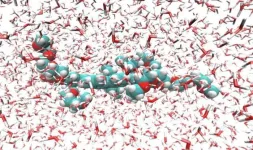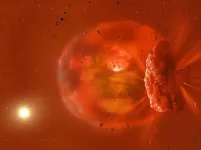(Press-News.org) Absorption spectroscopy is an analytical chemistry tool that can determine if a particular substance is present in a sample by measuring the intensity of the light absorbed as a function of wavelength. Measuring the absorbance of an atom or molecule can provide important information about electronic structure, quantum state, sample concentration, phase changes or composition changes, among other variables, including interaction with other molecules and possible technological applications.
Molecules with a high probability of simultaneously absorbing two photons of low-energy light have a wide array of applications: in molecular probes for high-resolution microscopy, as a substrate for data storage in dense three-dimensional structures, or as vectors in medicinal treatments, for example.
Studying the phenomenon by means of direct experimentation is difficult, however, and computer simulation usually complements spectroscopic characterization. Simulation also provides a microscopic view that is hard to obtain in experiments. The problem is that simulations involving relatively large molecules require several days of processing by supercomputers or months by conventional computers.
To overcome this difficulty, an alternative method of calculation has been proposed by physicist Tárcius Nascimento Ramos and collaborators in an article published in The Journal of Chemical Physics (JCP).
Ramos obtained a PhD in 2020 at the University of São Paulo’s Physics Institute (IF-USP) in Brazil, with a scholarship from FAPESP. He is currently a researcher with the National Fund for Scientific Research (F.R.S.-FNRS) at the University of Namur in Belgium.
“We evaluated the performance of a semi-empirical method much used in past decades but more recently neglected by the scientific community owing to its approximative nature. Using this method, we were able to reduce calculation time to four hours in a conventional computer. The low computing cost enabled us to consider a large statistical sample for simulations of molecules in solutions, which isn’t feasible with the currently hegemonic method,” Ramos told Agência FAPESP.
The currently hegemonic method is density functional theory (DFT), a mathematical tool widely used in quantum mechanics to describe the electronic properties of complex systems without having to investigate the individual wave functions of each electron.
“The alternative method we used was INDO/S [intermediate neglect of differential overlap with spectroscopic parameterization]. It’s based on the wave function of the molecular system but resolves approximately. Parts of the complex and computationally costly calculations are replaced by tabulated values obtained by adjusting experimental spectroscopic data. This makes the method highly efficient for theoretical studies of large molecular compounds,” Ramos explained.
The practicality of this method can be sensed by taking into consideration the fact that the molecule studied, which is derived from stilbene, has more than 200 atoms (of carbon, oxygen and hydrogen). Besides the number of components, which alone would make conventional simulations extremely laborious and expensive, these large molecules have an additional complication: they are flexible, and their electronic properties change when they change shape (by twisting, for example).
“At the end of the study, we bridged the experimental gap by characterizing at the microscopic level the one- and two-photon absorption spectra for this class of molecules. We found that the semi-empirical method we tested, often neglected owing to its approximative nature, is the most suitable for predicting the one- and two-photon absorption spectra of large molecules in solution. This finding points to a route for molecular engineers to develop novel compounds with greater efficiency in their various application branches,” Ramos said.
Here it may be useful to examine the difference between one- and two-photon absorption. The general principle is that molecules absorb photons only when they can assume excited states that are compatible with the energy of the photons. The selection rules for one-photon absorption are not the same as for two-photon absorption, so that excited states prohibited for the former may be permitted for the latter. Owing to this difference, plus the high spatial resolution of excitation by two photons resulting from its non-linear optical nature, molecules that can absorb two photons are suitable for much more refined uses.
“Microscope imaging with two-photon absorption has far higher resolution and can be used to characterize deep tissue with less damage to the surrounding structures. In the case of data storage, the high resolution means 3D structures can be created with precision and plenty of detail, so that points inside materials can be encoded with high data density per volume,” Ramos explained.
Computer modeling of two-photon absorption by organic molecules in solution was the subject of Ramos’s PhD research. The JCP article refers to another step forward in this investigation.
Besides the doctoral scholarship awarded to Ramos, the study was supported by FAPESP via two other projects (14/50983-3 and 15/20032-0). The co-authors are Sylvio Canuto (last author, IF-USP), Daniel Luiz da Silva (Federal University of São Carlos, UFSCar, Brazil), and Leandro Franco (Karlstad University, Sweden).
About São Paulo Research Foundation (FAPESP)
The São Paulo Research Foundation (FAPESP) is a public institution with the mission of supporting scientific research in all fields of knowledge by awarding scholarships, fellowships and grants to investigators linked with higher education and research institutions in the State of São Paulo, Brazil. FAPESP is aware that the very best research can only be done by working with the best researchers internationally. Therefore, it has established partnerships with funding agencies, higher education, private companies, and research organizations in other countries known for the quality of their research and has been encouraging scientists funded by its grants to further develop their international collaboration. You can learn more about FAPESP at www.fapesp.br/en and visit FAPESP news agency at www.agencia.fapesp.br/en to keep updated with the latest scientific breakthroughs FAPESP helps achieve through its many programs, awards and research centers. You may also subscribe to FAPESP news agency at http://agencia.fapesp.br/subscribe.
END
Absorption of light by molecules has applications in microscopy, medicine and data storage
An alternative method proposed by a Brazilian physicist cuts the time for computer simulation of the absorption spectrum from two days to a few hours.
2023-10-11
ELSE PRESS RELEASES FROM THIS DATE:
SwRI’s Dr. Nicholas Mueschke named AIAA Associate Fellow
2023-10-11
SAN ANTONIO — October 11, 2023 —Southwest Research Institute’s Dr. Nicholas Mueschke has been named an Associate Fellow of the American Institute of Aeronautics and Astronautics (AIAA).
AIAA Associate Fellows are recognized for overseeing important engineering or scientific work and outstanding contributions to their field. Associate Fellows must be recommended by at least three other associate fellows, be a senior member in good standing of the AIAA and have at least 12 years of professional experience. AIAA selects only one Associate Fellow for each 150 members each year.
The AIAA selected Mueschke for ...
New research finds greater continuity of psychotherapy after shift to telehealth
2023-10-11
WASHINGTON, D.C., Oct. 11, 2023 — The rapid transition to virtual care that occurred with the onset of the COVID-19 pandemic resulted in better continuity of psychotherapy visits compared to prior to the pandemic when almost all visits were in-person, according to new research published in Psychiatric Services, a journal of the American Psychiatric Association. In addition, the time between appointments grew shorter after the transition to virtual care. The study results highlight the benefits of continued availability of virtual psychotherapy.
This ...
Newsmakers: Basic research findings by Johns Hopkins scientists focus on gene sequencing, hearing loss and a brain disorder
2023-10-11
FOR IMMEDIATE RELEASE
Yes, Scientists Have Sequenced the Entire Human Genome, But They’re Not Done Yet
The human genome, from end to end, has been sequenced, meaning scientists worldwide have identified most of the nearly 20,000 protein-coding genes. However, an international group of scientists notes there’s more work to be done. The scientists point out that even though we have nearly converged on the identities of the 20,000 genes, the genes can be cut and spliced to create approximately 100,000 proteins, and gene experts are far from agreement on what those 100,000 proteins are.
The group, which convened last fall at Cold Spring Harbor Laboratory in New York, has now ...
Icahn School of Medicine at Mount Sinai and the University of California San Diego receive $8.5 million award to establish a data integration hub for NIH Common Fund supported programs
2023-10-11
New York, NY [October 11, 2023]—Researchers at the Icahn School of Medicine at Mount Sinai and the University of California San Diego have been awarded an $8.5 million grant to create a data integration hub aimed at accelerating novel therapeutics and cures for diseases within initiatives supported by the National Institutes of Health (NIH) Common Fund.
NIH Common Fund programs are large-scale projects designed to collect cutting-edge biomedical research data from human cells, tissues, and patients to rapidly ...
Warm summers and wet winters yield better wine vintages
2023-10-11
Wine quality is notorious for varying from year to year, but what makes for a “good year”? In a paper publishing October 11 in the journal iScience, researchers show that weather plays an important role in determining wine quality. By analyzing 50 years’ worth of wine critic scores from the Bordeaux wine region in relation to that year’s weather, the researchers showed that higher quality wine is made in years with warmer temperatures, higher winter rainfall, and earlier, shorter ...
Cleaner air brings a wetter high mountain Asia
2023-10-11
High Mountain Asia (HMA), encompassing the Tibetan Plateau and the surrounding Hindu Kush, Karakoram, and Himalayan ranges, harbors the world's third-largest amount of glacial ice. It is the source of more than 10 major Asian rivers and vital water resources for nearly 2 billion people.
Recent decades have witnessed a dipolar trend in HMA precipitation, characterized by an increase in the north but a decrease in the southeast. These changes have significant implications for water resource security and ecological equilibrium in both local ...
Researchers capture first-ever afterglow of huge planetary collision in outer space
2023-10-11
The study, published today in Nature, reports the sighting of two ice giant exoplanets colliding around a sun-like star, creating a blaze of light and plumes of dust. Its findings show the bright heat afterglow and resulting dust cloud, which moved in front of the parent star dimming it over time.
The international team of astronomers was formed after an enthusiast viewed the light curve of the star and noticed something strange. It showed the system doubled in brightness at infrared wavelengths some three years before the star started to fade in visible light.
Co-lead author Dr Matthew Kenworthy, from Leiden University, ...
Certain navigational mistakes could be early signs of Alzheimer’s disease
2023-10-11
People with early Alzheimer’s disease have difficulty turning when walking, according to a new study using virtual reality led by UCL researchers.
The study, published in Current Biology, used a computational model to further explore the intricacies of navigational errors previously observed in Alzheimer’s disease.
Researchers, led by Professor Neil Burgess and colleagues in the Space and Memory group* at the UCL Institute of Cognitive Neuroscience, grouped participants into three categories: healthy younger participants (31 total), healthy elderly participants (36 total) and patients with mild cognitive impairment (43 total). They then asked ...
Survival outcomes by race and ethnicity in veterans with prostate cancer
2023-10-11
About The Study: The findings of this study of nearly 13,000 veterans with nonmetastatic castration-resistant prostate cancer suggest that differences in outcomes by race and ethnicity exist. In addition, Black and Hispanic men may have considerably improved outcomes when treated in an equal-access setting.
Authors: Kelli M. Rasmussen, M.S., of the University of Utah School of Medicine in Salt Lake City, is the corresponding author.
To access the embargoed study: Visit our For The Media website at this link https://media.jamanetwork.com/
(doi:10.1001/jamanetworkopen.2023.37272)
Editor’s Note: Please see the article for additional information, including ...
Perceived and objective fertility risk among female survivors of adolescent and young adult cancer
2023-10-11
About The Study: Survivors of adolescent and young adult cancer had high rates of perceiving increased infertility risk but frequently overestimated or underestimated their risk in this study that included 785 participants. These findings suggest that counseling on infertility risk throughout survivorship may reduce misalignment between perceptions and actual risk, decrease fertility-related psychological distress, and inform family planning decisions.
Authors: H. Irene Su, M.D., M.S.C.E., ...
LAST 30 PRESS RELEASES:
Support for parents with infants at pediatric check-ups leads to better reading and math skills in elementary school
Kids’ behavioral health is a growing share of family health costs
Day & night: Cancer disrupts the brain’s natural rhythm
COVID-19 vaccination significantly reduces risk to pregnant women and baby
The role of vaccination in maternal and perinatal outcomes associated with COVID-19 in pregnancy
Mayo Clinic smartwatch system helps parents shorten and defuse children's severe tantrums early
Behavioral health spending spikes to 40% of all children’s health expenditures, nearly doubling in a decade
Digital cognitive behavioral treatment for generalized anxiety disorder
Expenditures for pediatric behavioral health care over time and estimated family financial burden
Air conditioning in nursing homes and mortality during extreme heat
The Alps to lose a record number of glaciers in the next decade
What makes a good proton conductor?
New science reporting guide published for journalists in Bulgaria
New international study reveals major survival gaps among children with cancer
New science reporting guide published for journalists in Turkey
Scientists develop a smarter mRNA therapy that knows which cells to target
Neuroanatomy-informed brain–machine hybrid intelligence for robust acoustic target detection
Eight SwRI hydrogen projects funded by ENERGYWERX
The Lundquist Institute and its start-up company Vitalex Biosciences Announces Strategic Advancement of Second-Generation fungal Vaccine VXV-01 through Phase 1 Trials under $40 Million Competitive Con
Fine particles in pollution are associated with early signs of autoimmune disease
Review article | Towards a Global Ground-Based Earth Observatory (GGBEO): Leveraging existing systems and networks
Penn and UMich create world’s smallest programmable, autonomous robots
Cleveland researchers launch first major study to address ‘hidden performance killer’ in athletes
To connect across politics, try saying what you oppose
Modulating key interaction prevents virus from entering cells
Project explores barriers to NHS career progression facing international medical graduates
Jeonbuk National University researchers explore the impact of different seasonings on the flavor perception of Doenjang soup
Two Keck Medicine of USC Hospitals named Leapfrog Top Teaching Hospitals
World-first discovery uncovers how glioblastoma tumours dodge chemotherapy, potentially opening the door to new treatments
A fatal mix-up: How certain gut bacteria drive multiple sclerosis
[Press-News.org] Absorption of light by molecules has applications in microscopy, medicine and data storageAn alternative method proposed by a Brazilian physicist cuts the time for computer simulation of the absorption spectrum from two days to a few hours.



